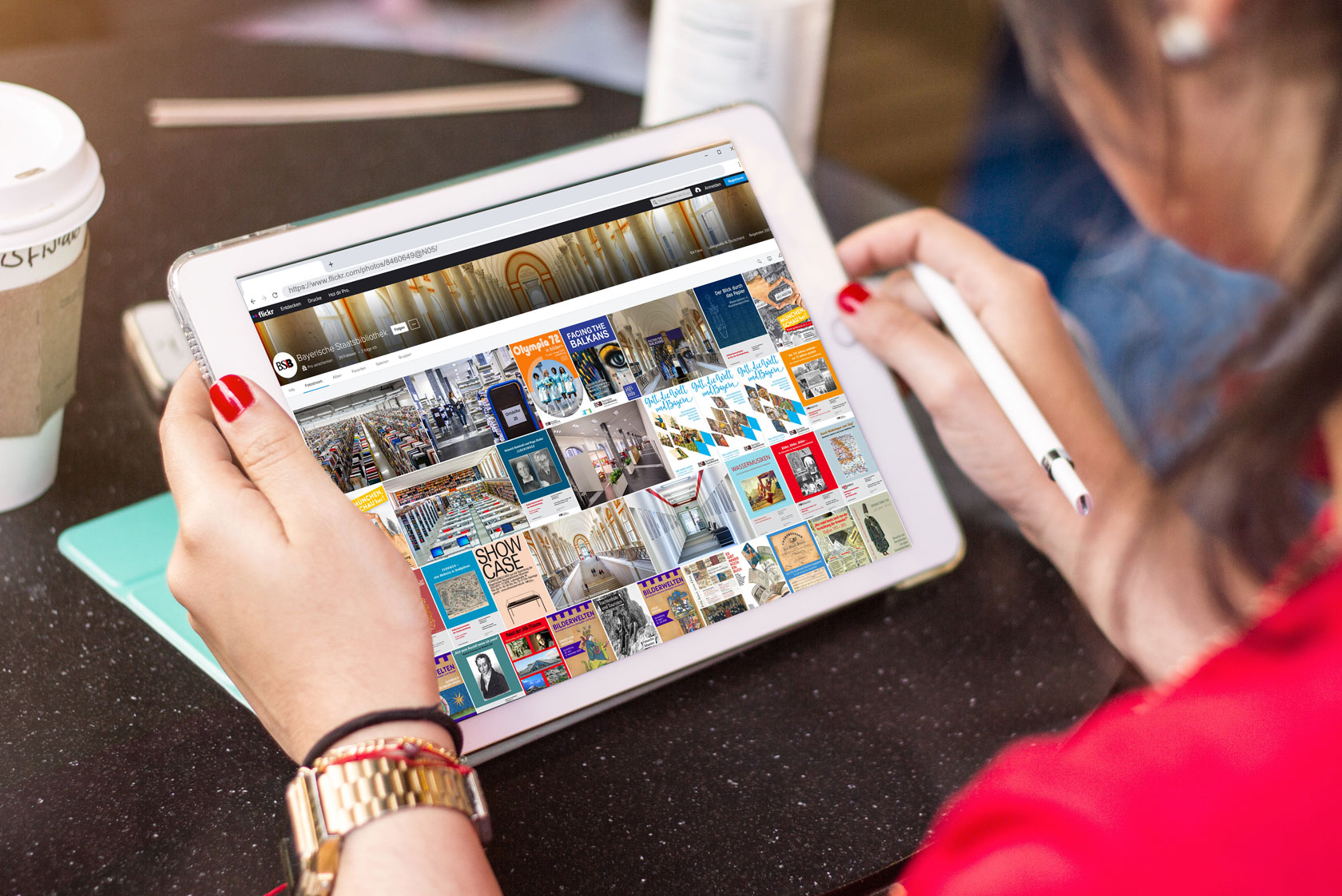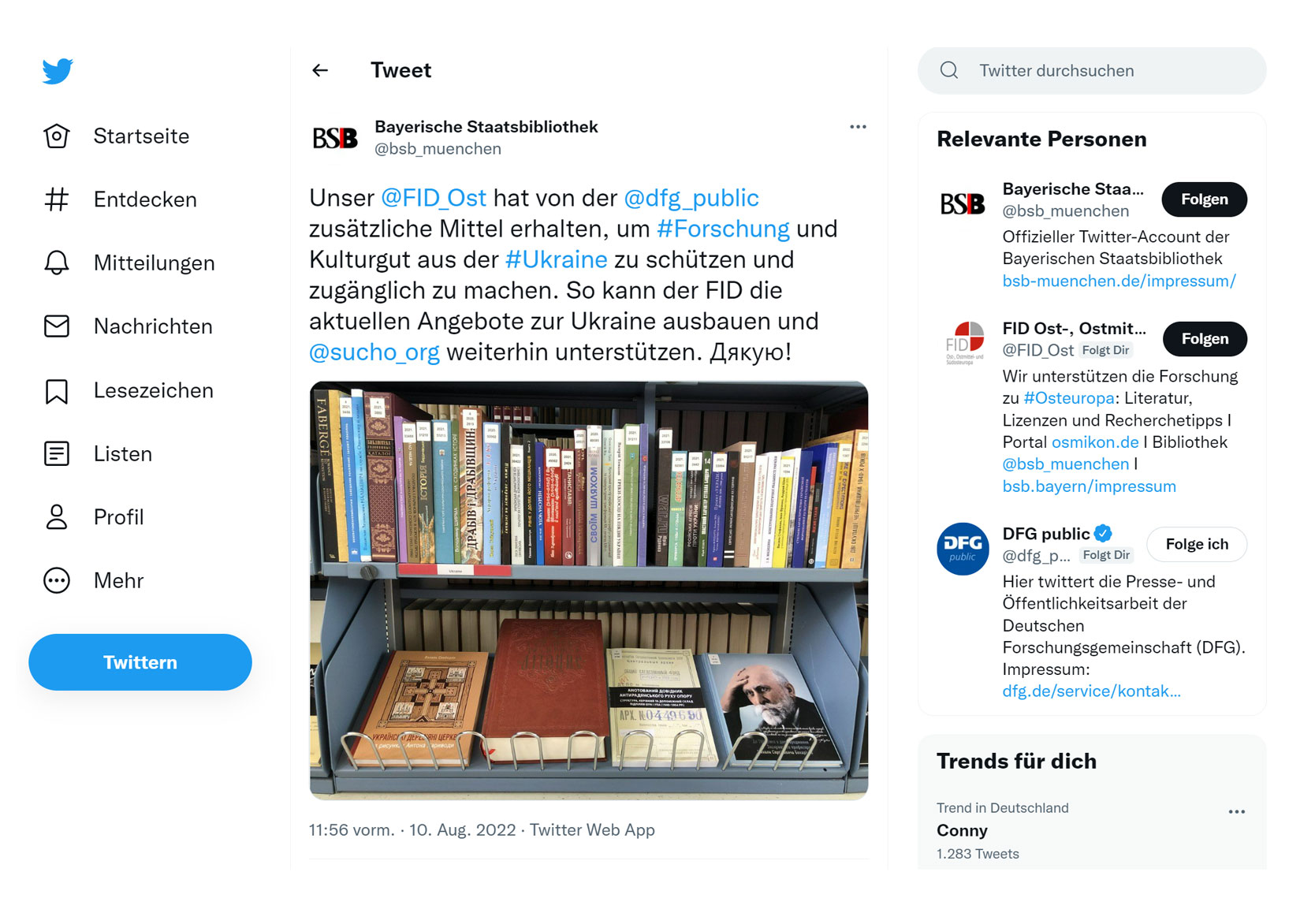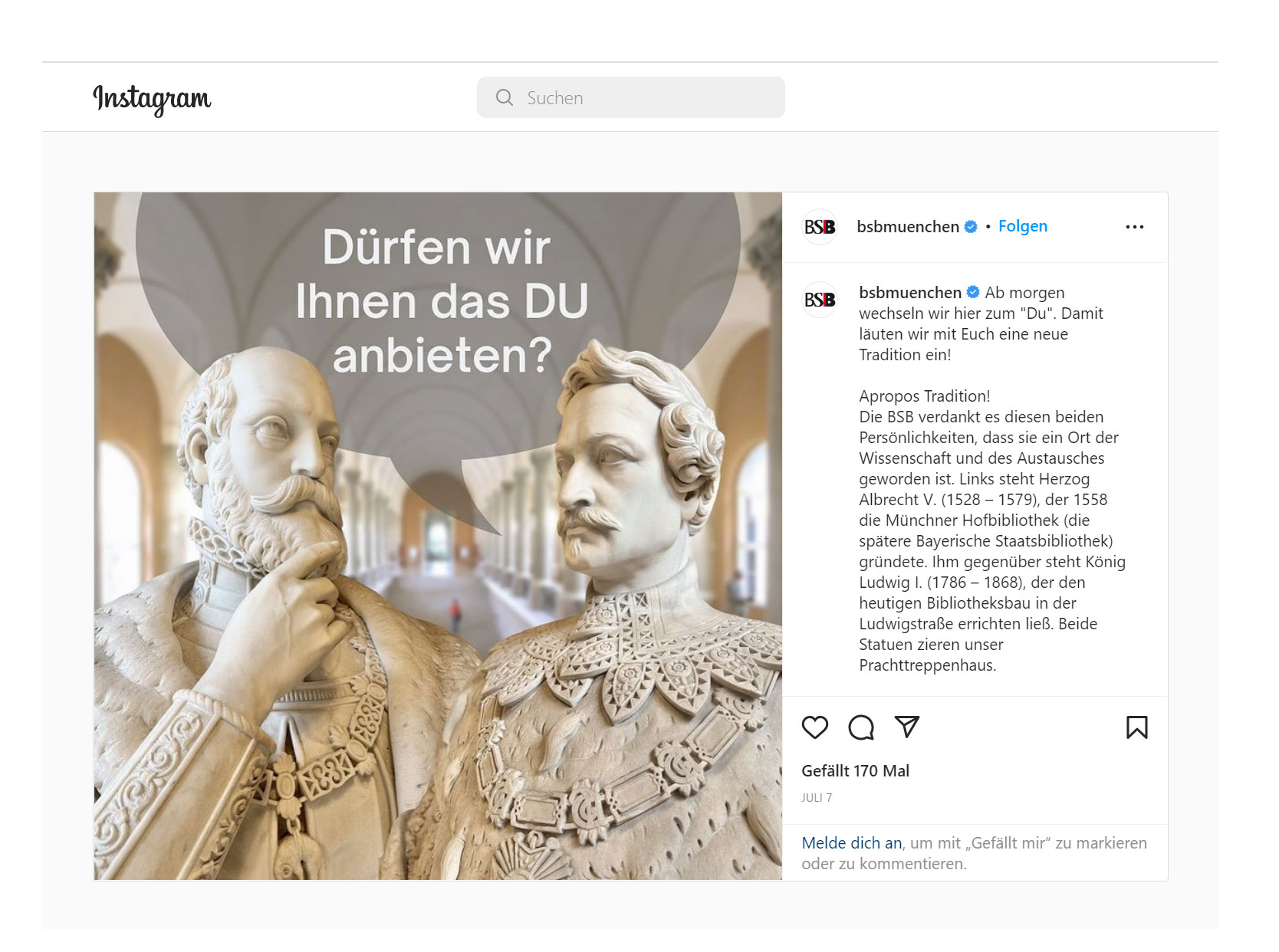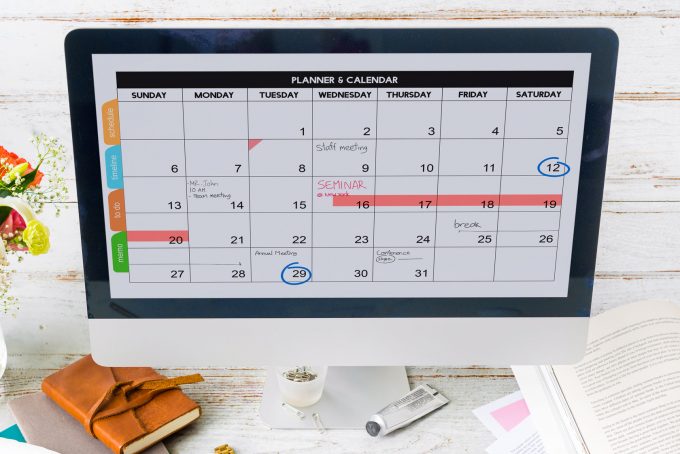
Social Media in Libraries: Best Practice and Tips for Successful Profiles From the Bayerische Staatsbibliothek
For many years, it has been good practice for many libraries to be present in social media and to provide their target groups with relevant information there. The Bayerische Staatsbibliothek is particularly successful in this field in German-speaking countries. In an interview with two staff members from the press and public relations division, we try to get to the bottom of their success!
Especially when looking at the Facebook (around 11,000 followers) and Instagram channels (3,700 followers) of the Bayerische Staatsbibliothek (BSB), it quickly becomes clear that they are doing something pretty right on social media. In addition, the BSB is active on Twitter, YouTube and Flickr in various ways. We asked two members of staff about their target groups, recipes for success and topics that are doing particularly well.
An interview with Peter Schnitzlein and Sabine Gottstein from the press and public relations division of the Bayerischen Staatsbibliothek in Munich.

Why do you think it is important for libraries and digital infrastructure institutions to be active on social media?
Here we can only refer to the interview published on ZBW MediaTalk on the seven “glorious” reasons: Why libraries have to be permanently active on social media!
Today, certain target groups can simply no longer be reached with “classic” communication channels such as press relations or a library magazine – regardless of whether they are published in analogue or digital form. These target groups are more likely to be reached – differentiated according to age and content – via the appropriate and corresponding social media channels. This does not mean that classic communication work will disappear in the foreseeable future – on the contrary. However, it can be stated that social media engagement is taking up an increasingly larger share of a library’s overall communication. We have to take this into account.
You are very active on social media at the Bayerische Staatsbibliothek. What are your goals with and target groups on the different channels? Why did you choose these of all channels?
The aim of the engagement in social media is primarily to inform about the Bayerische Staatsbibliothek, its services, holdings and information and usage offers, to interest people in the library or to positively influence the perception of the library and, if necessary, to strengthen the bond with the library through entertaining elements. The activities serve to make the library visible to the digital or virtual public as an internationally important general and research library as well as an important cultural institution on a local, regional and national level. The social media ideally support the strategic goal of the BSB to be perceived as Germany’s leading digital library with extensive, innovative digital usage offers and as a treasure house of written and visual cultural heritage. We attach great importance to participation and networking with specialist communities and stakeholders in our communication.
As extensive and wide-ranging as the fields of action of the Bayerische Staatsbibliothek are, as diverse and varied are the target groups that need to be considered and served. We operate our own channels on Twitter, Instagram, Facebook, YouTube and Flickr. With these five social media channels selected by the library, we hope to be able to address the majority of the target groups in an appropriate manner. Roughly formulated and certainly strongly generalised, we can state the following:
- Twitter primarily serves professional communities, thematically related institutions or multiplier groups such as press and media representatives.
- Instagram is intended to reach a younger target group (20-35 years of age),
- Whereas Facebook is aimed more at the 30 to 55 age group. The two channels should appeal to users as well as to a broad audience with an affinity for culture and libraries.
- With YouTube, we want to address not exclusively, but primarily everyone over 16, actually everyone who is at home in the digital world. Explanatory videos on webinars, on how to use the library or a new app are just as much in demand here as the presentation of special library treasures. Video content is currently the measure of all things and we will pay special attention to this channel in the future.
- We use the photo portal Flickr less as a social media channel than as a documentation site, to offer important pictures of the building or of exhibition posters in one central place, and for external requests for pictures of the BSB.
In addition to the corporate channels, the Bayerische Staatsbibliothek also operates numerous specialist channels for individual departments, projects or specialist information services. The reason for this is the fact that certain (specialist) target groups cannot be successfully addressed through corporate channels. In view of the immense range of subject areas covered by the BSB, the central social media editorial team cannot have the professional expertise needed to cover all these topics in detail. Coordination processes would be too time-consuming and lengthy to successfully create content and to be able to act quickly and efficiently – a very important aspect in social media communication.
How long have you been present in social media?
The Bayerische Staatsbibliothek dedicated itself to this field of communication relatively early on. We have been active on Facebook, Twitter and YouTube since 2009, on Flickr since 2007 and on Instagram since 2016. At present, we have no plans for further expansion of activities. In view of the short-lived nature and speed of innovation in this area, however, this may change in the short term. In this respect, only a daily status report is possible here.
What topics take place on your social media channels?
The content that the BSB posts can be summarised well, as mentioned above, under “inform, interest, entertain”. The same content is often published on Facebook and Twitter, although more specialist topics that are primarily intended to interest the specialist community and multipliers tend to be published on Twitter. On Instagram, the decisive criterion is always the appealing picture, and recently video. In general, a certain entertainment factor plays just as much a role on Instagram as on Facebook as the primary approach of informing.
In order to “feed” the social media channels well for an institution like yours, you need people who think of the social media team and pass on information and stories, who are perhaps also willing to make an appearance themselves. How do you get other staff to provide you with information, stories and ideas for your channels?
The topics are recruited in close cooperation and constant exchange with our internal specialist departments. There are social media contacts there who report relevant content from their own department to the central social media editorial team. The latter, in turn, also inquires specifically in the departments if necessary. Our directorate expressly supports and welcomes the active participation of the departments, project groups and working groups in the social media work of the house.
The social media team also actively establishes references to other cultural and academic institutions, picks up on library-relevant topics and comments on them. The creation of a thematic and editorial calendar with anniversaries, jubilees, events, etc. also facilitates the identification of suitable content for the social media channels.
In the press and public relations division, something like a central “newsroom” is currently being set up. This is also, where information for press topics or content for library magazines should come in. The social media editorial team will automatically learn about topics, which are primarily intended for other communication channels. The team can then decide to what extent they should be included in the social media work.
Which topics or posting formats work particularly well for you and why?
In general, we can see that postings related to current events work well:

Tweet of the Bayerische Staatsbibliothek regarding the participation in the SUCHO (Search for Ukrainian Cultural Heritage) project (German)
For example, our tweets condemning the invasion of Ukraine (German) or our participation in the SUCHO project (Search for Ukrainian Cultural Heritage, German) achieved a wide reach, as did a humorous tip to cool off in the hot summer month of July. The start of a library exchange with colleagues from the German National Library (DNB) and the Staatsbibliothek zu Berlin (Berlin State Library; SBB), which just started in Munich, triggered many interactions on Twitter.
On Facebook, the World Book Day post (German) on 22 April referring to the Ottheinrich Bible, one of our magnificent manuscripts, together with a series of archive photos of archive photos of Queen Elisabeth II (German) ) on the occasion of her death were very successful.
Appealing images on Twitter and Facebook – especially posts with three- or four-image compositions – are still crucial for success. Embedding videos on these two social networks, on the other hand, surprisingly does not achieve the desired result on our channels. On the contrary. These posts and tweets achieve low reach and popularity.
On Instagram, on the other hand, short videos in the form of reels are becoming more and more important alongside good picture posts in the feed (German), accompanied by casual, often humorous descriptions. We used this format successfully, especially for our exhibition #olympia72inbildern (#olympia72inpictures, German). Both formats also benefit from being referred to via stories.
Sometimes things go wrong in social media. What was your best fail?
Fortunately, nothing has ever really gone wrong – with one exception (see below). However, every now and then we are (justifiably) reminded that we should not forget to gender in our tweets.
Have you ever had a shitstorm? What have you learned from it?
Yes, we had, at least to some extent – and we don’t like to think back on it. However, we have learned a lot from the incident in dealing with social media. The basic mistake at the time was not to have taken into account the specific requirements of each channel with regard to the wording, the approach to followers and fans and the willingness to explain.
Tips & tricks: What are your tips for libraries that would like to get started with social media?
First of all, it is important to do an honest and thorough analysis. Social media ties up resources, and quite a lot of them. Just doing it “on the side” will not lead to the desired result and harbours dangers. If you want to be active, you must have affine personnel with the appropriate know-how and sufficient time resources. It is indispensable to define the target groups and to identify a permanently sufficient number of topics.
While social media was text-based in the early days, today there is no post or tweet without a picture. On some channels, video content is now the measure of all things, just think of the reels on Instagram, video platforms like YouTube or the omnipresent TikTok. They are currently becoming more and more popular and setting trends. These developments must be taken into account in all considerations of online communication.
If you want to use social media as a means of library communication, you have to check whether you can actually afford to operate all the channels that are currently important and which target groups you actually want to serve with which channels. Creating a written concept – even a short one if necessary – helps to answer these questions precisely. For example, concentrating on one channel, true to the motto “less is more”, may be an effective means of operating successfully with limited resources.
Finally, a little peek into the magic box: What are your favourite tools for social media?
With “Creator Studio”, feed posts for Instagram can also be posted conveniently from the computer and not only from the mobile phone, which makes work considerably easier. Then, of course, there is the editorial and topic plan mentioned above. It is the central working tool for keeping track of and working through topics and content across all channels. In addition to news from the management and the departments, it contains as many events, occasions, relevant (birth or death) anniversaries, etc. as possible. Finally, the apps “Mojo” and “Canva” should be mentioned. With their help, we create and edit Instagram stories, reels, social media posts and visual content. This even goes as far as adding royalty-free music to clips.
This text has been translated from German and is licensed under CC BY-NC-ND.
The Bayerische Staatsbibliothek on the net
This might also interest you:
- Briefly Noted: ZBW MediaTalk in Test Mode on Mastodon
- Why Libraries Have to be Permanently Active on Social Media: 7 „Glorious“ Reasons – 2021 Update
- Scientific tweets: Why Less is More and When a Tweet is Perceived as Being Scientific
- Study on Twitter Usage: What Roles Do Academic Hierarchies Play?
- Benefit from Twitter as a Learning Tool: Learning in Social Networks
- User Experience for Libraries: The Best Tools and Methods for Beginners
This blog article is licensed under CC BY-NC-ND.
Peter Schnitzlein passed the final examination for graduate librarian (upper level- graduate of a specialized higher education institution (research libraries)), in 1993 and the modular qualification for the highest career bracket for civil servants in Germany (QE4) in 2018. He has been head of press and public relations and spokesman of the Bayerische Staatsbibliothek since 2007.
Portait: BSB©, photographer: H.-R. Schulz
Sabine Gottstein studied language, economic and cultural area studies, worked in the field of communications in Germany and abroad and has been working for the Bayerische Staatsbibliothek since 2015. She is the head of the social media team in the press and public relations division.
Portait: BSB©, photographer: H.-R. Schulz
View Comments

Anniversary of re3data: 10 Years of Active Campaigning for the Opening of Research Data and a Culture of Sharing
re3data, the largest directory for research data, is celebrating its tenth birthday....




